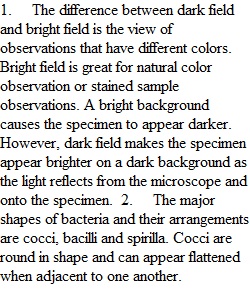


Q Required Resources • Review the Lab Safety document in the files section and take the lab safety quiz. Check with your instructor if you have any questions. • Complete the Week Prelab Activity (Connect) Instructions Welcome to the (online) lab page. You should have already completed the Lab Safety virtual lab simulation on Labster. Here is where you will upload your completed lab document. Grading This activity will be graded using the rubric in the lab document. Course Outcomes (CO): 8 Due Date: By 11:59 p.m. MT on Sunday PreviousNext Lab 6: Bacterial Cell Structures: An Introduction to the Bacterial Cell Virtual Simulation Lab Learning Outcomes • Describe the general bacterial cell structure and function, including differentiating between the most common shapes of bacteria and cell arrangements. • Describe the general bacterial cytoplasmic content and compare it to eukaryotic cytoplasmic content. • Describe special features of bacteria such as plasmids, flagella or inclusion bodies and how they are necessary for bacteria to survive Introduction: Global warming is causing the ice to melt in Antarctica, leading to the discovery of bacteria that have survived this extreme environment. In this simulation, you will learn about bacterial cell structures and how these are important for bacterial survival. Identify Bacteria in a Sample from Antarctica First you will collect a sample of melted ice from Antarctica that contains various bacteria. Your task is to investigate what is in the sample, and which bacterial cell structures are important for bacterial survival. Study and Assemble Bacterial Cell Structures In order to analyze your bacterial sample and to understand the bacterial cell’s internal and external structures, you will explore the motility features and shapes of bacteria in your sample. You will also compare the outer and inner bacterial cell structures to that of the Eukaryotic cell and assemble the cytoplasmic content of the bacterial and the Eukaryotic cell. Apply Your Knowledge Finally, you will compare your bacterial cell structures to other bacteria and learn which cellular structures are important for the bacteria to survive in extreme environments. Can you help the Arctic researchers decide which survival features they should study? Record your responses to the questions from simulation (these are in addition to the questions below). Questions: 1. Describe the difference between dark field and bright field microscopy?
Q 2. What are the major shapes of bacteria and their arrangements? 3. Give 5 differences between eukaryote and prokaryotic cells? 4. What is the difference between the cell wall and the cell membrane?5. Reflection: Write 5 sentences on what you learned from this simulation; what did you like and what was something that you would not prefer to be on simulation?
View Related Questions